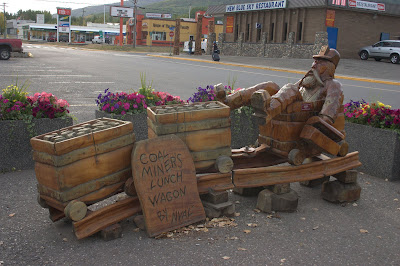 |
| Mount Shasta in Northern California. |
We have taken nine days to drive down from Canada to home. We are not doing much sightseeing – we are saving Washington and Oregon for future trips.
 |
| The Peace Arch, as we crossed from Vancouver into Washington. |
We did stay in the Tillamook, Oregon area for a day to tour the Tillamook Cheese Factory, see the Naval Air Museum which is housed in a WWII blimp hangar and to take a very nice quilt tour, where large quilt blocks are painted on historic barns throughout the area. We had dinner with my nephew, Mike Purcell, and his family and had a terrific visit.
 |
| My nephew, Mike Purcell, and his beautiful family. |
 |
| Of course, we see lots of wildlife in Oregon (but not in Alaska) - a herd of elk near the Tillamook airport. |
 |
| A home-built blimp at the Tillamook Air Museum. The museum in housed in a WWII blimp hangar, made entirely of wood. |
 |
| One of the quilt tour blocks. The tour takes you on a very scenic drive through the Tillamook countryside. The dairy smells reminded me of my growing up days in Artesia. |
 |
| Corrigan and his new friends enjoying their Tillamook ice cream inside a Tillamook loaf van. |
We made our way from the Oregon coast to Sisters, Oregon on a windy, rainy day to visit a quilt shop which several of my quilting buddies said was a must see. And since we were on the east side of the Cascades, we stayed there and traveled down from Bend, Oregon through Klamath Falls into California. Glad we did since the weather improved significantly – clear and dry with highs in the 70s and 80s. Haven’t seen that since a couple days we had in Fairbanks.
We stayed one day in the Mount Shasta area in order to see a niece of mine, Dawne Ramshaw, and her family. Had a great dinner and visit with them.
 |
| My neice, Dawne Ramshaw, and her family (minus a daughter who is away at college). It was so good to see them and get caught up on news. |
 |
| Mt. Shasta as seen from our campground at Lake Siskiyou. |
 |
| A group of six deer including several fawns who still had their spots visited a spot near our campsite both afternoons that we were there. |
It will be good to get back into the “old” routine, I think. But I wonder if I will miss the traveling, if I will be bored by the sameness of everyday life back in Long Beach.
We started this trip back on June 6th. One hundred and ten days later, we have traveled over 14,000 miles, stayed at about 40 campgrounds, taken three glacier cruises and one sternwheeler ride, toured too many museums and have seen a representative set of Alaskan critters. We replaced one tire and a bathroom sink. We drove almost every paved road in Alaska and over 350 miles of dirt/gravel roads. We are returning home with a broken kitchen drawer and a busted gas pipe in the oven. Actually not bad, considering the condition of the roads we traveled.
A trip to Alaska has been a dream of mine since my twenties. Was it what I thought it would be? Yes and no. The condition of the Alaska Highway is much better than I thought it would be, although it is much rougher than any of the roads I have been on in the lower 48. Traveling with a trailer is pretty convenient – your own kitchen, bathroom and bed whenever you need them. And it is extremely comfy to sit in your warm, dry trailer while rain is pouring down outside. Of course, getting out there to hook up your trailer for your next day’s travel isn’t too much fun, but Russ didn’t seem to mind. I thought we would spend more time relaxing at our various campsites, sitting around campfires and enjoying the scenery, but the cold temperatures, rain and the mosquitoes pretty much put an end to that most days. Traveling without deadlines or schedules is as freeing as I imagined it to be.
The size of Alaska is mindboggling. With all the miles we drove, we saw just a small fraction of the state. There are national parks you can get to only by small plane, boat or dogsled (and yes, dogsleds are used on a regular basis in this part of the country.) There are icefields larger than some states in the lower 48. And the number of really tall mountains and glaciers seems uncountable.
I find it impossible to describe the beauty and wildness of the Alaskan and Yukon scenery. To stand on the Top of the World Highway and gaze on a seemingly endless string of forested mountain ridges with no evidence of any human presence other than the dirt road stretching in front of us …I found myself thanking God for the world He created and for giving me the opportunity to see it in this pristine form. When we toured the tidewater glaciers and saw some of the marine life up close, I found myself hoping that humankind can take heed and change behaviors to preserve the environment. We are all so interconnected with nature and we, for the most part, ignore that interdependency or just pay it token heed.
I highly recommend Alaska. If you don’t have time to take four months and drive up there, then take a cruise, fly up and rent an RV for two weeks, or just rent a car and drive around. Buy a Milepost book, get on the road, and go. It is incredible.




























































